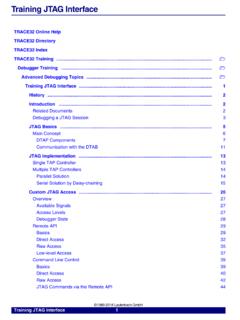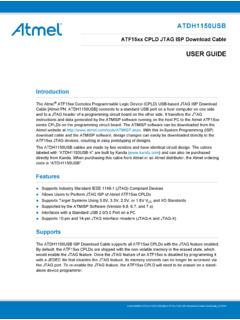Transcription of Report No: AN101 In-System Programming (ISP) of the Atmel ...
1 Application Note 101 SPI In-System Programming (ISP) Implementation for the Atmel AVR Microcontroller Family Version: 11th Feb 09 1 Report No: AN101 Title: In-System Programming (ISP) of the Atmel AVR FLASH Microcontroller Family using the SPI Programming Interface Author: Date: Version Number: John Marriott 11th Feb 09 Abstract: This application note describes how to develop and implement In-System Programming (ISP) support for the Atmel AVR microcontroller family using the SPI Programming Interface . The document details how to make a Programming Project which will operate on any Equinox ISP programmer. A full description of how to implement In-System Programming (ISP) of the Atmel AT89S, AT90S, AT90 USB, ATmega and ATtiny AVR FLASH Microcontroller is also included.
2 The application note describes the physical connections required from the programmer to the target Microcontroller and also details the different ISP Header Connector pin-outs which are currently available. All rights are reserved. Reproduction in whole or in part is prohibited without the prior written consent of the copyright owner. The information presented in this document does not form part of any quotation or contract, is believed to be accurate and reliable and may be changed without prior notice. No liability will be accepted by the publisher for any consequence of its use. Publication thereof does not convey nor imply any license under patent or other industrial or intellectual property rights Application Note 101 SPI In-System Programming (ISP) Implementation for the Atmel AVR Microcontroller Family Version: 11th Feb 09 2 Contents 4 Programmers supported.
3 4 Device Support .. 5 SPI Algorithm Overview .. 6 jtag Algorithm 7 SPI Programming Algorithm .. 8 Overview of the SPI Programming 8 Atmel AVR Microcontroller - SPI Implementation .. 9 Atmel AT90S AVR Microcontrollers .. 10 Atmel ATmega AVR 11 Overview of possible ATmega pin-outs .. 11 ATmega AVR - Standard SPI 12 ATmega AVR - UART SPI Pin-out .. 13 ISP Header Selection Chart (by header).. 14 Creating an SPI Programming 16 Overview .. 16 Information required to create an SPI Project .. 16 Creating an EDS (Development project).. 17 Launching EDS and selecting a Target Device .. 17 Target Oscillator Settings ..18 Target System Power Supply Settings .. 19 Specifying the FLASH (Code) 20 Specifying the EEPROM (Data) 21 Launching EDS at the end of the EDS Wizard.
4 22 Testing an SPI Project in Development (EDS) 23 SPI Programming 24 24 Hardware SPI Mode ..24 Software SPI 24 Using Hardware SPI Mode .. 25 25 Optimum SPI Frequencies for each 26 Using Software SPI mode .. 27 Choosing the fastest possible SPI 28 28 Programming the CKSEL Fuses to select a faster Oscillator Frequency .. 28 Creating a Standalone Project which programs the fuses before Programming the FLASH / EEPROM .. 29 Testing SPI communication with the Target Chip .. 30 Programming the FLASH Area .. 31 Programming the EEPROM Area .. 33 Erasing the FLASH / EEPROM 35 Erasing the FLASH 35 Erasing the EEPROM area special considerations .. 35 Programming the Configuration Fuses .. 36 36 Reading the Fuses from a Target 36 Verifying the Fuses of a Target Device.
5 37 Writing the Fuses into a Target Device .. 38 Using a Fuse File to import Fuse settings into a project .. 38 Importing Fuse Settings in HEX format from AVR Studio .. 38 Programming the Security 39 Application Note 101 SPI In-System Programming (ISP) Implementation for the Atmel AVR Microcontroller Family Version: 11th Feb 09 Overview .. 39 Reading the Security Fuses from a Target Device .. 40 Verifying the Security Fuses of a Target 40 Writing the Security Fuses into a Target 41 Erasing the Security Fuses .. 41 Using a Fuse File to import Security Fuse settings into a project .. 41 Importing Security Fuse Settings in HEX format from AVR 41 Exporting an EDS Project to a Standalone Project .. 42 Exporting / Importing Fuse Settings to / from 43 Overview.
6 43 Exporting the Fuse Settings to a Fuse 43 Copying the Fuses from a Target Device .. 43 Importing the Fuse Settings from a Fuse 43 Importing Fuse Settings in HEX format from AVR Studio .. 44 Overview .. 44 Finding the AVR Studio Hex Fuse Values .. 44 Importing the AVR Studio Hex Fuse Values into EQTools .. 45 Importing the AVR Studio Hex Security Fuse Values into EQTools .. 48 Creating a Standalone Project .. 51 Overview .. 51 Creating a Standalone Project from EDS (Development Mode) .. 51 Add Project File to a new Project Collection .. 51 Uploading a Project to a 52 Re-testing a Project in EDS (Development mode) .. 53 Application Note 101 SPI In-System Programming (ISP) Implementation for the Atmel AVR Microcontroller Family Version: 11th Feb 09 Introduction This application note describes how to develop and implement In-System Programming (ISP) support for the Atmel AVR microcontroller family using the SPI Programming Interface.
7 The document details how to make a Programming Project which will operate on any Equinox ISP programmer. A full description of all connection methods required to implement In-System Programming (ISP) of the Atmel AT89S, AT90S, AT90 USB, ATmega and ATtiny AVR FLASH Microcontroller is also discussed. The document describes the physical connections required from the programmer to the target Microcontroller and also details the different ISP Header Connector pin-outs which are currently available. Please note: Programming of the Atmel AVR microcontroller family using the jtag Programming Interface is covered in Application Note AN105. The Atmel ATtiny AVR Family features both a Low Voltage and High Voltage Serial Programming Modes.
8 Please refer to Application Note - AN104 for further details. Programmers supported Most Equinox ISP Programmers support Programming of Atmel AVR microcontrollers using the SPI Programming Interface as standard see table below. It is also possible to upgrade many of these programmers to support Programming via the jtag Programming Interface . Fig. Equinox Programmer SPI and jtag ISP Support Programmer SPI algorithms jtag algorithms Upgrade Order Code EPSILON5 YES UPGRADE EPSILON5-UPG3 EPSILON5(AVR- jtag ) NO YES N/A FS2003 YES UPGRADE FS2003-UPG7 FS2009 YES UPGRADE FS2009-UPG7 FS2009(AVRJTAG)
9 NO YES N/A PPM3 MK2 YES UPGRADE + IO-CON-3 jtag Connector Module + Special Function Module PPM3A1-UPG7 PPM4 MK1 YES UPGRADE + IO-CON-3 jtag Connector Module + Special Function Module PPM4MK1-UPG7 ISPnano UPGRADE -TBC UPGRADE - TBC TBC Key: YES - Enabled as standard UPGRADE Chargeable license upgrade required TBC Details to be confirmed (please e-mail for further details.) Application Note 101 SPI In-System Programming (ISP) Implementation for the Atmel AVR Microcontroller Family Version: 11th Feb 09 Device Support Please refer to the latest Device Support List for the devices which are currently supported by the Equinox range of programmers. This can be found: - as a Download available on the website: Click on the Downloads tab.
10 Under Download Type choose Device Support Lists / Release notes then click Search. - Browsing on the Device Support tab under each product. - In the latest version of EQ-Tools: Launch EQ-Tools. Go to Programmer ; Create a Device Support. All programmers and devices supported are listed in this document. You will need the most recent EQ-Tools build version please refer to the website for further details. Some ATmega devices such as the ATmega8(L) and ATmega161(L) do not have a jtag port and so cannot support jtag Programming . Please note: Devices with greater than 128kb of FLASH memory require a firmware upgrade to version or above in order to support Programming of the upper 128kb. It is possible to program devices connected in a jtag Chain using firmware or above.





